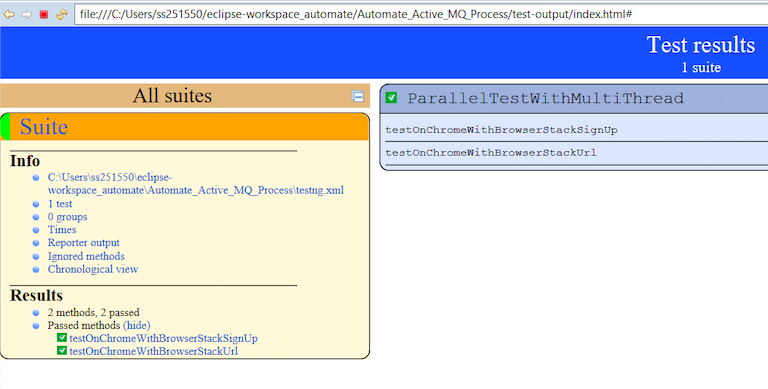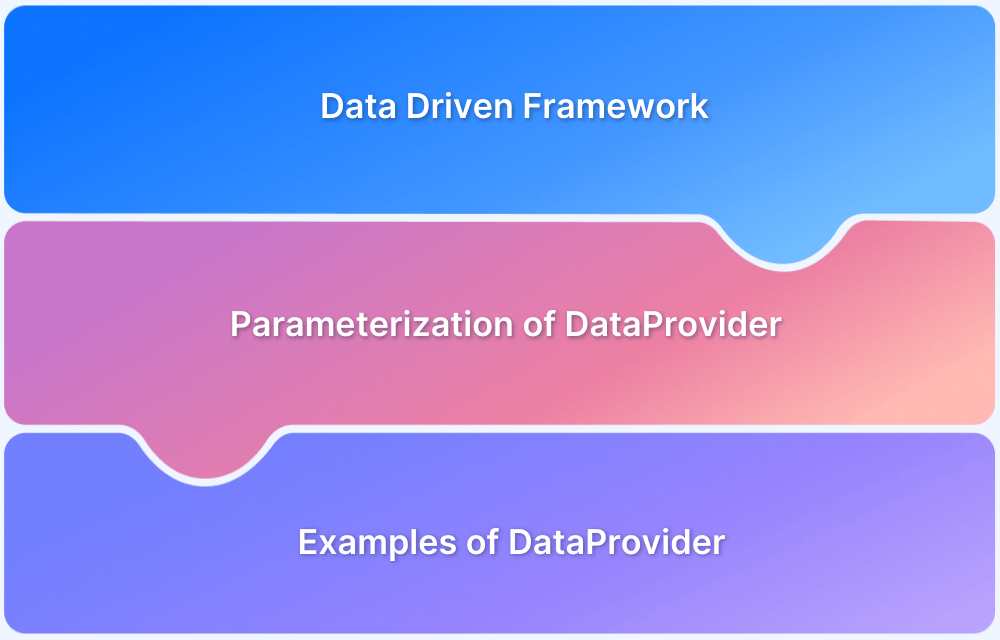As software applications grow in complexity, the size of test suites increases, leading to longer execution times. Running tests sequentially often delays feedback, slows down the release cycle, and increases time-to-market. This is where parallel testing helps by running multiple tests simultaneously.
Overview
Parallel execution in Selenium allows multiple tests to run concurrently across different browsers, devices, or configurations, helping teams save time and improve test efficiency.
How to Run Parallel Tests using TestNG and Selenium
- Set the parallel attribute in the TestNG XML suite file (methods, classes, tests, or instances) to specify the parallel execution level.
- Define the thread-count in the XML file to control how many tests run in parallel.
- Configure tests for different browsers using separate methods (e.g., Chrome, Firefox).
- TestNG uses multi-threading to execute tests concurrently.
- Test execution details and reports are generated automatically by TestNG.
This article covers what parallel testing is, how to implement it with Selenium, its advantages and challenges, and how cloud platforms like BrowserStack help teams scale effectively.
What is Parallel Testing (also referred to as Parallel Test Execution)?
Parallel testing involves executing tests for different modules or applications simultaneously across multiple browsers, instead of running them one after another.
This approach contrasts with sequential testing, where tests for various modules or functionalities run consecutively. Even when testing across multiple browsers, sequential execution runs tests one browser at a time, which is time-consuming.
By running tests in parallel, execution time and effort are significantly reduced, leading to faster delivery. Parallel testing is especially beneficial for cross-browser testing, compatibility testing, localization, and internationalization testing.
For example, when two software versions need stability and compatibility checks, running tests simultaneously on both versions accelerates issue identification and resolution.
Parallel Testing using TestNG and Selenium
The following code snippet demonstrates the parallel execution process. It includes two methods: one opens the BrowserStack homepage using Chrome, while the other performs a sign-up on the BrowserStack platform using Firefox. Both methods are executed in parallel by setting the thread count to 2 in the TestNG XML configuration. Refer to the code snippet and TestNG XML file below:
<suite name="Parallel_Testing" parallel="methods" thread-count="2">
The parallel attribute can be extended for multiple values, as below:
- Methods: Helps run methods in separate threads
- Tests: Help to run all methods belonging to the same tag in the same thread
- Classes: Helps to run all methods belonging to a class in a single thread
- Instances: Helps run all methods in the same instance in the same thread
Along with the parallel attribute, the thread-count attribute helps in defining the number of threads one wishes to create while running the tests in parallel. For example, in case one has three methods, with thread count as two, then during execution, two threads shall start in parallel with the corresponding methods. As the first method execution is completed, and the thread gets free, it takes up the next method in the queue.
Let’s look into the code snippet to understand the parallel execution process. In the example below, I have created two methods. One uses chrome to open the Browserstack homepage where the other uses the firefox browser to sign up on the Browserstack platform. In this code snippet, we are executing both these methods in parallel, by setting up the thread count in the TestNG XML file as 2. Refer to the below snippet and TestNG XML file:
import org.testng.annotations.AfterClass;
import org.testng.annotations.Test;
import org.testng.annotations.Test;
import java.util.concurrent.TimeUnit;
import org.openqa.selenium.By;
import org.openqa.selenium.WebDriver;
import org.openqa.selenium.chrome.ChromeDriver;
import org.openqa.selenium.edge.EdgeDriver;
import org.openqa.selenium.firefox.FirefoxDriver;
import org.openqa.selenium.ie.InternetExplorerDriver;
import org.testng.annotations.Test;
public class ParallelTestWithMultiThread {
WebDriver driver;
@Test()
public void testOnChromeWithBrowserStackUrl()
{
System.setProperty("webdriver.chrome.driver", ".\\Driver\\chromedriver.exe");
driver=new ChromeDriver();
driver.manage().timeouts().implicitlyWait(10, TimeUnit.SECONDS);
driver.get("https://www.browserstack.com/");
driver.manage().window().maximize();
System.out.println("this is the test related to chrome browserstack homepage"+ " " +Thread.currentThread().getId());
}
@Test()
public void testOnChromeWithBrowserStackSignUp()
{
System.setProperty("webdriver.gecko.driver", ".\\Driver\\geckodriver.exe");
driver=new FirefoxDriver();
driver.manage().timeouts().implicitlyWait(10, TimeUnit.SECONDS);
driver.get("https://www.browserstack.com/users/sign_up");
driver.manage().window().maximize();
driver.findElement(By.id("user_full_name")).sendKeys("<name>");
driver.findElement(By.id("user_email_login")).sendKeys("<login email id>");
driver.findElement(By.id("user_password")).sendKeys("<password>");
System.out.println("this is the test related to chrome browserstack login"+ " " +Thread.currentThread().getId());
}
@AfterClass
public void close()
{
driver.quit();
}
}
TestNG Xml file:
<?xml version="1.0" encoding="UTF-8"?> <!DOCTYPE suite SYSTEM "https://testng.org/testng-1.0.dtd"> <suite name="Suite" parallel="methods" thread-count="2"> <test name="Test"> <classes> <class name="ParallelTestWithMultiThread"/> </classes> </test> <!-- Test --> </suite> <!-- Suite -->
TestNG Report:
Based on the requirements, one can set up the thread count and parallel attribute.
Using cloud platforms like BrowserStack enables running Selenium tests in parallel on real browsers and devices, boosting test reliability while eliminating the need for local infrastructure and speeding up execution.
The Execution Race – Parallelization vs Serialization
Here is a case study to illustrate how parallelization accelerates testing and enhances return on investment. Consider the example with two test methods running on different browsers: one on Chrome and the other on Firefox.
In one scenario, the methods are executed sequentially, while in the other, both methods run in parallel using two concurrent threads. The image below displays the time taken for sequential execution.
The below image indicates the time taken to execute both the methods in parallel:
The data indicates that parallel execution reduces the total test time by approximately 1.5 times compared to sequential execution. This decrease in execution duration facilitates faster testing cycles, expedited delivery, and improved ROI.
Read More: Best Practices for Selenium Test Automation
Advantages of Parallel Test Excution in Selenium
The following key advantages highlight why parallel test execution in Selenium is essential for efficient and effective automated testing:
- Faster Test Completion: Selenium’s support for parallel execution enables multiple tests to run concurrently, significantly reducing overall execution time.
- Cross-Browser Testing Efficiency: Parallel execution allows simultaneous testing across different browsers, improving test coverage and detecting browser-specific issues early.
- Better Resource Utilization: Leveraging parallel threads optimizes system or cloud resources, enabling more tests to run without additional hardware.
- Improved Test Reliability: Running tests in isolated threads reduces interference between tests, leading to more stable and reliable results.
- Accelerated Feedback for Developers: Faster test runs provide quicker insights into code quality, supporting agile development and continuous integration workflows.
- Scalability with Cloud Services: Selenium tests can be run in parallel on cloud platforms, enabling scalable testing across numerous devices and environments without infrastructure constraints.
Disadvantages of Parallel Testing in Selenium
While parallel testing offers many benefits, it also presents certain challenges and limitations that must be carefully managed:
- Requirement for Independent Test Modules: For parallel testing to be effective, test modules must be designed to run independently. Modules with interdependencies cannot be executed in parallel, limiting the scope of parallelization.
- Complex Test Design and Setup: Successful parallel testing demands a thorough understanding of the application’s architecture and workflow to design tests that can run concurrently without conflicts.
- Limited Browser Coverage Without Distributed Testing: While parallel testing supports cross-browser compatibility checks, its ability to cover multiple browsers simultaneously is limited unless combined with distributed testing infrastructure that provisions multiple machines and browser instances.
- Increased Resource Consumption: Running multiple tests in parallel can consume significant computational resources, requiring robust infrastructure or cloud services to manage the load efficiently.
- Potential for Flaky Tests: Improperly managed parallel tests may lead to flaky or inconsistent results due to shared resource contention or environmental issues.
Read More: How to run Parallel Tests with CircleCI
The era of Cloud-Based Testing
Parallel testing requires access to multiple platforms and browsers, which can increase the cost and complexity of compatibility testing. Additionally, it is often challenging to maintain access to all required browser versions and device configurations locally.
Cloud platforms have revolutionized testing by providing scalable access to real devices and browsers without the need for local infrastructure. They reduce costs, increase test coverage, and enable rapid access to the latest environments.
Key benefits include:
- On-demand scalability for running large parallel test suites
- Access to a broad spectrum of real devices and browser versions
- Reduced maintenance and setup overhead compared to in-house labs
- Improved accuracy through real-device testing versus emulators
- Seamless updates with new OS and browser releases
- Integration support with CI/CD pipelines for continuous testing
Read More: Selenium Grid Tutorial : How to Set It Up
Why Choose BrowserStack for Parallel Testing with Selenium?
BrowserStack is a leading cloud testing platform designed to optimize Selenium parallel testing with unique features and services:
- Extensive Device and Browser Matrix: Test on thousands of real browsers and devices including legacy and latest versions without additional setup.
- Built-in Selenium Grid: Run Selenium tests in parallel across multiple browsers and devices instantly, with minimal configuration.
- Reliable and Stable Infrastructure: Minimize flaky tests with consistent, dedicated real device environments.
- Powerful Debugging Tools: Access real-time logs, screenshots, and video recordings to identify and fix issues efficiently.
- Seamless CI/CD Integration: Easily plug into popular tools like Jenkins, CircleCI, and GitHub Actions for automated parallel testing.
- Security and Compliance: Enterprise-grade security ensures test data and sessions remain private and compliant.
BrowserStack enables teams to accelerate test execution, improve test reliability, and simplify the maintenance of parallel Selenium test suites with a real device cloud platform.
Conclusion
Parallel testing using TestNG and Selenium offers a powerful approach to speed up automated test execution by running tests concurrently across multiple browsers and environments. This method reduces testing time significantly while maintaining comprehensive coverage.
Although it demands careful structuring of test cases and resources, integrating it with cloud platforms like BrowserStack simplifies infrastructure management and enhances test reliability. By combining TestNG’s parallel execution capabilities with Selenium’s automation and BrowserStack’s scalable real device cloud, teams can accelerate release cycles, improve cross-browser compatibility, and deliver higher-quality software efficiently.









